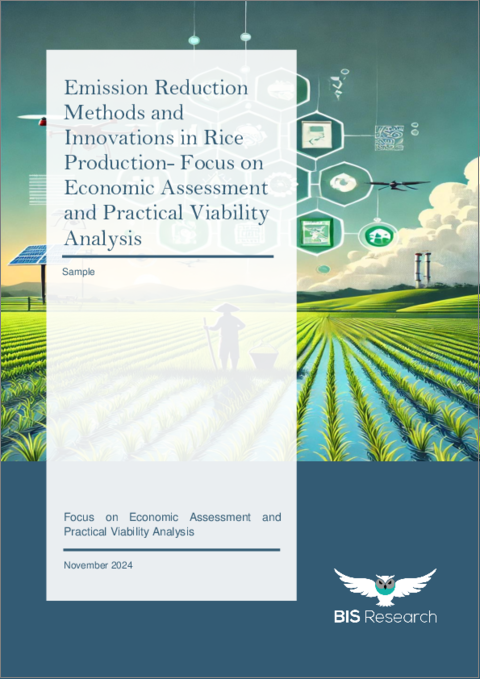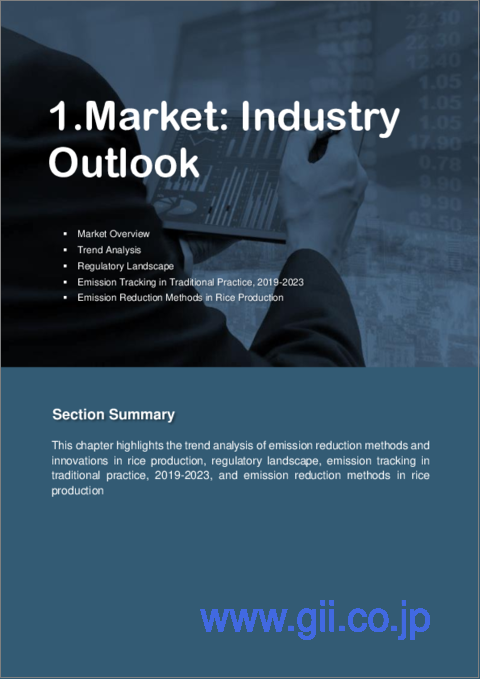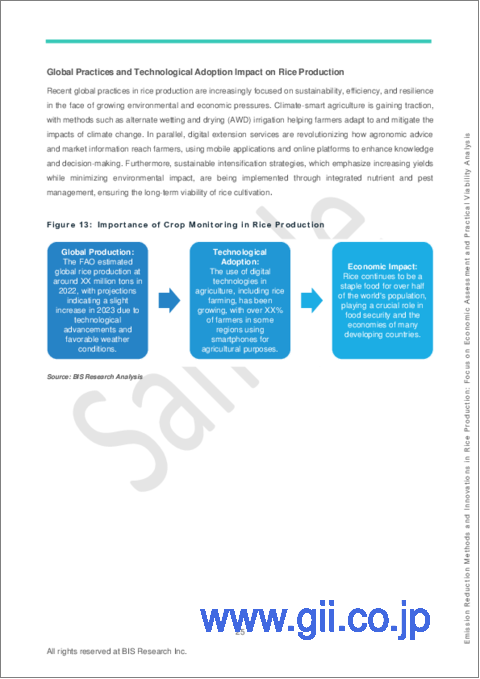|
|
市場調査レポート
商品コード
1617394
米の生産における排出削減手法とイノベーション:経済的評価・現実的な実行可能性の分析Emission Reduction Methods and Innovations in Rice Production: Focus on Economic Assessment and Practical Viability Analysis |
||||||
カスタマイズ可能
|
|||||||
| 米の生産における排出削減手法とイノベーション:経済的評価・現実的な実行可能性の分析 |
|
出版日: 2024年12月19日
発行: BIS Research
ページ情報: 英文 83 Pages
納期: 1~5営業日
|
全表示
- 概要
- 図表
- 目次
米の生産は世界の何百万人もの人々、特に米を主食とするアジアの人々の食糧安全保障と経済的生活の礎となっています。
しかし、伝統的な稲作は、温室効果ガス (GHG)、特にメタン (CH2) と亜酸化窒素 (N2O) の排出に大きく寄与しています。世界の人口が増加し、2050年には34%増加すると予測される中で、環境への影響を最小限に抑えながら需要を満たす米生産への圧力は強まっています。
近年、EUのGreen DealやGlobal Methane Pledgeなどを含む世界の政策やイニシアチブは、気候変動目標の達成に向けた重要なステップとして、農業排出量の削減に焦点を当てています。特にEUのGreen Dealは、EUが2050年までに気候中立を達成することを目指しており、2030年までに化学農薬の使用量を50%削減、施肥量を20%削減するといった中間目標が掲げられています。こうした規制は欧州市場に影響を及ぼすだけでなく、EUとの農産物貿易が盛んな国々にも影響を及ぼし、補助金、炭素クレジット、技術投資を通じて持続可能な慣行を奨励します。
米生産は世界の食糧安全保障に不可欠である一方で、温室効果ガス (GHG) の排出が大きいため、持続可能な慣行への適応をますます迫られています。湛水田からのメタン排出だけでも、世界の農業メタン排出総量の約10~12%を占めています。環境規制が強化され、持続可能性に対する市場の要求が高まる中、米産業は重大な岐路に立たされており、生産性と環境スチュワードシップを両立させるイノベーションが求められています。
上述の種目標を達成するため、米業界はAWD (Alternate Wetting and Drying)、SRI (System of Rice Intensification)、精密農業ツール、バイオ炭などの土壌改良など、さまざまな排出削減技術を取り入れています。これらの方法は、排出量を削減するだけでなく、資源効率と作物収量を向上させます。例えば、AWDはメタン排出量を最大48%削減でき、SRIは水使用量を削減し生産性を向上させるため、水の乏しい地域では魅力的な手法となります。
当レポートでは、米の生産における排出削減手法とイノベーションの動向を調査し、排出削減に向けた各種政策・イニシアチブ、排出削減技術の種類と概要、主要国における排出削減技術の導入率と成功指標、排出削減技術の経済的評価などをまとめています。
目次
エグゼクティブサマリー
調査範囲
第1章 市場:業界の展望
- 市場概要
- 規制状況
- 従来の慣行における排出追跡
- 米生産における排出削減手法
- AWD (Alternate Wetting and Drying)
- 好気性稲作
- SRI (System of Rice Intensification)
- メタン排出削減戦略
- 亜酸化窒素排出削減戦略
- 水田における炭素隔離
第2章 米生産における革新的技術と実践
- 作物モニタリング
- VRT
- 精密植え付け
- 灌漑技術
- データ管理およびサポートシステム
- 作物残渣管理
- 排出削減技術の導入率と成功指標 (主要国別)
- 中国
- インド
- インドネシア
- ベトナム
- ブラジル
- 日本
- 米国
- 韓国
- イタリア
- スペイン
- ギリシャ
- その他
第3章 排出削減技術の経済的評価
- さまざまな技術の費用便益分析
- 排出削減のための補助金とインセンティブ
- 排出削減技術の経済的影響指標
- 欧州の米生産者のためのROI分析
- 現実的な実行可能性の分析
- 実装の課題
- 成功事例
- 排出削減活動の実行可能性指標
第4章 総論・提言
- 主な調査結果
- 将来の排出削減目標に対する技術と実践の影響
- 欧州の米生産者の技術導入の将来の展望
第5章 調査手法
List of Figures
- Figure 1: Three Objectives of Emission Reduction Methods and Innovations in Rice Production
- Figure 2: Major Sectors of GHG Emissions in Agriculture
- Figure 3: Emission Reduction Techniques
- Figure 4: Framework of Emissions Reduction from Rice Production
- Figure 5: Global Rice Production Trends (2019-2023)
- Figure 6: Global Rice Consumption Trends (2019-2023)
- Figure 7: Top 10 Rice Consuming Countries (2020-2021 and 2022-2023: Annual Average Consumption, Milled Basis
- Figure 8: Overview of Emissions Tracked from Traditional Rice Production
- Figure 9: Year-Wise Percentage Increase for Emissions in Traditional Rice Production from 2019 To 2023
- Figure 10: Benefits of Alternate Wetting and Drying Method
- Figure 11: Countries Representing Alternate Wetting and Drying Method
- Figure 12: Countries Representing Alternate Wetting and Drying Method
- Figure 13: Key Benefits
- Figure 14: Why to Transform Conventional Rice to Aerobic Rice
- Figure 15: Adoption of Aerobic Rice Cultivation Method
- Figure 16: Countries With SRI Utilization in their NDCs
- Figure 17: Benefits and Adoption of System of Rice Intensification (SRI)
- Figure 18: Global Consumption of CRFs vs Nitrogen Fertilizers
- Figure 19: Expected Emission Reduction with AgroForestry Adoption
- Figure 20: Patents Filed or Granted for Agroforestry (Global), January 2018-December 2022
- Figure 21: Importance of Crop Monitoring in Rice Production
- Figure 22: Importance of Crop Monitoring in Rice Production
- Figure 23: Importance of Crop Monitoring in Rice Production
- Figure 24: Benefits of VRT in Rice Production
- Figure 25: VRT Implementation
- Figure 26: Technologies Adopted
- Figure 27: Expected Emission Reduction with Precision Agriculture Adoption
- Figure 28: Different Types of Irrigation Technology
- Figure 29: Global Framework of Irrigation Technology
- Figure 30: Regional Analysis of Irrigation Technology for Rice Production:
- Figure 31: Case Study: The success story
- Figure 32: Major Methods:
- Figure 33: Regional Focus and Government Initiatives on Crop Residue Management
- Figure 34: Highlights of Economic Impacts
- Figure 35: Highlights of Sensitivity Analysis
- Figure 36: Implementation Challenges from Various Emission Reduction Technologies
- Figure 37: EU's Action Plan for Promoting the Farm-to-Fork Strategy
- Figure 38: Emission Reduction Methods and Innovations in Rice Production: Focus on Economic Assessment and Practical Viability Analysis: Research Methodology
List of Tables
- Table 1: Regulatory Landscape
- Table 2: Comparison between SRI and Conventional Method of Rice Cultivation
- Table 3: Adoption Rate and Succes Matrix of Emission Reduction Technology (by Key Country)
- Table 4: Cost-Benefit Analysis (CBA)
- Table 5: Subsidies and Incentives for Emission Reduction Technologies in Rice Production
- Table 6: Economic Impact Metrics of Emission Reduction Technologies in Rice Production
- Table 7: Summary of Economic Impact Metrics
- Table 8: Subsidies and Incentives for Emission Reduction Technologies in Rice Production
- Table 9: Viability Metrics for Emission Reduction Practices in Rice Production
Market Introduction
Rice production is a cornerstone of food security and economic livelihood for millions worldwide, particularly in Asia, where rice serves as a staple food. However, traditional rice cultivation practices contribute significantly to greenhouse gas (GHG) emissions, especially methane (CH2) and nitrous oxide (N2O), primarily due to flooded field conditions and fertilizer usage. As global populations grow, with an anticipated 34% increase by 2050, the pressure on rice production to meet demand while minimizing environmental impact is intensifying.
In recent years, global policies and initiatives, including the EU Green Deal and the Global Methane Pledge, have emphasized reducing agricultural emissions as a critical step toward achieving climate targets. The EU Green Deal, in particular, aims for the EU to achieve climate neutrality by 2050, with interim targets such as a 50% reduction in chemical pesticide use and a 20% reduction in fertilizer application by 2030. Such regulations not only influence European markets but also affect countries heavily engaged in agricultural trade with the EU, incentivizing sustainable practices through subsidies, carbon credits, and technological investments.
Industrial Impact
The rice production industry, while essential to global food security, faces increasing pressure to adapt to sustainable practices due to its significant greenhouse gas (GHG) emissions. Methane emissions from flooded rice paddies alone contribute approximately 10-12% of total global agricultural methane emissions. With heightened environmental regulations and market demands for sustainability, the rice industry is at a critical juncture, requiring innovations that balance productivity with environmental stewardship.
Key policies such as the EU Green Deal, Global Methane Pledge, and national climate commitments are pushing countries to implement emission reduction strategies in agriculture, including rice farming. For instance, under the EU Green Deal, the European Commission (EC) has set ambitious goals for the agricultural sector: reducing pesticide use by 50%, fertilizer use by 20%, and shifting 25% of farmland to organic practices by 2030. These regulations influence not only EU rice markets but also impact major rice-exporting countries that trade with the EU, spurring them to align with sustainable practices.
To meet these targets, the rice industry is embracing various emission reduction technologies such as Alternate Wetting and Drying (AWD), System of Rice Intensification (SRI), precision agriculture tools, and soil amendments like biochar. These methods not only decrease emissions but also enhance resource efficiency and crop yields. For instance, AWD can reduce methane emissions by up to 48%, while SRI reduces water use and improves productivity, making it an attractive method in water-scarce regions.
Several industrial players, including agricultural technology firms and seed producers, are developing new tools to support emission reduction in rice farming. Companies like Deere & Company and Syngenta have invested in precision agriculture equipment, while BASF SE and Yara International are working on low-emission fertilizers. Additionally, collaborations between governments and private enterprises are on the rise. Through programs like the EU's Horizon 2020, funding and incentives are directed towards sustainable rice production initiatives, including water-saving technologies, controlled-release fertilizers, and smart agriculture practices.
Despite these advancements, the industry faces significant challenges. The high initial cost of technology, limited access to funding for smallholder farmers, and inadequate technical support hinder the large-scale adoption of emission reduction methods. Moreover, successful adoption of data-driven systems like Variable Rate Technology (VRT) or Data Management Supporting Systems (DMSS) requires robust infrastructure and digital literacy, both of which are often lacking in rural rice-growing regions.
Nonetheless, the industry impact of emission reduction in rice farming is promising. By implementing sustainable practices, rice producers can improve their resilience to climate impacts, gain access to carbon credit markets, and meet rising consumer demand for sustainable products. If adopted widely, these practices could contribute significantly to reducing global agricultural emissions and advancing climate goals, while also opening new economic opportunities within the rice production sector.
Adoption of Water Management Practices-particularly Alternate Wetting and Drying (AWD)
A crucial factor in reducing emissions in rice production is the adoption of Alternate Wetting and Drying (AWD), a water management practice that lowers methane emissions by up to 48%. Unlike traditional continuous flooding, AWD involves intermittently drying fields, which interrupts methane-producing bacteria. This method not only reduces emissions but also cuts water use by about 30%, benefiting areas with water scarcity and lowering irrigation costs. AWD is cost-effective and accessible for smallholders, yet challenges remain, including the need for farmer training and technical support. With proper incentives and support, AWD has the potential to be a cornerstone in sustainable, low-emission rice farming.
Recent Developments
- Public-Private Investments: Programs like the EU's Horizon 2020 have funded numerous projects in sustainable rice farming. Companies such as Deere & Company, Syngenta, and Yara International are developing and promoting technologies like controlled-release fertilizers, precision irrigation, and crop monitoring systems to support emission reduction goals.
- Adoption of Smart Farming Technologies: Precision tools such as Variable Rate Technology (VRT) and drones are gaining traction in major rice-producing regions. These technologies enable optimized use of water, fertilizers, and pesticides, reducing emissions and conserving resources.
- Carbon Sequestration Initiatives: Agroforestry and conservation tillage in rice paddies are being adopted to enhance soil carbon storage. Countries such as India and Vietnam are integrating carbon credit programs with these practices, creating financial incentives for farmers to adopt sustainable techniques.
- Government-Led Incentives: Governments in Asia, the U.S., and the EU are introducing incentives, subsidies, and carbon credits for emission reduction technologies in rice production. Vietnam's VnSAT project and India's National Action Plan on Climate Change (NAPCC) offer support for farmers adopting water-saving methods like AWD and SRI.
How Can This Report Add Value to an Organization?
Product/Innovation Strategy: The report provides insights into various emission reduction methods in rice production, such as Alternate Wetting and Drying (AWD), System of Rice Intensification (SRI), and precision irrigation. These sustainable practices enable rice producers to align with global climate goals and reduce greenhouse gas emissions, primarily methane and nitrous oxide. By detailing each method's efficiency, cost-benefit analysis, and adoption challenges, the report equips stakeholders with a comprehensive understanding of how these technologies can be implemented across key rice-producing regions. The report highlights opportunities to capitalize on carbon credit schemes and government subsidies that incentivize the adoption of emission reduction technologies, offering a practical guide for organizations aiming to invest in low-emission rice production.
Growth/Marketing Strategy: The report analyzes significant developments in sustainable rice farming, including technological advancements, partnerships, and policy-driven incentives that promote emission reduction. Key players in the rice sector, such as technology providers and agricultural equipment manufacturers, are launching products and expanding operations to support sustainable practices. The report also outlines strategic partnerships, such as collaborations between government agencies and agricultural technology companies to facilitate training and equipment access for smallholders. For example, in 2024, several rice-producing countries in Asia and the U.S. rolled out AWD and crop residue management programs, supported by subsidies and financial incentives. These developments create an avenue for companies to broaden their customer base while meeting rising demand for sustainable, low-emission rice production solutions.
Competitive Strategy: The report profiles key rice-producing countries, comparing their progress in adopting emission reduction methods and sustainable farming practices. It analyzes the regulatory frameworks, infrastructure availability, and financial support that influence adoption rates in countries like China, India, Vietnam, and the United States. This competitive analysis helps stakeholders understand how countries stack against each other in emission reduction efforts and market maturity for sustainable rice farming. The report further explores regional incentives and barriers, providing a clear landscape of opportunities for companies to tailor their strategies according to each country's sustainability goals and regulatory requirements. This analysis helps organizations identify competitive advantages and potential areas for strategic expansion within the global low-emission rice production market.
Methodology
Primary Research
The primary sources involve the emission reduction from rice production industry experts and stakeholders such as platform developers and service providers. Respondents such as vice presidents, CEOs, marketing directors, and technology and innovation directors have been interviewed to verify this research study's qualitative and quantitative aspects.
The key data points taken from primary sources include:
- validation and triangulation of all the numbers and graphs
- understanding the competitive landscape of different technologies
Secondary Research
This research study involves the usage of extensive secondary research, directories, company websites, and annual reports. It also makes use of databases, such as Hoovers, Bloomberg, Businessweek, and Factiva, to collect useful and effective information for an extensive, technical, market-oriented, and commercial study of the global market. In addition to the aforementioned data sources, the study has been undertaken with the help of other data sources and websites, such as www.fao.org and www.worldbank.org.
Secondary research was done to obtain crucial information about the industry's value chain, revenue models, the market's monetary chain, the total pool of key players, and the current and potential use cases and applications.
The key data points taken from secondary research include:
- qualitative insights into various aspects of the market, key trends, and emerging areas of innovation
- quantitative data for mathematical and statistical calculations
Key Countries
The countries that are analysed have been selected based on inputs gathered from analysing the country's imports, export, and agricultural trade agreements.
Some major countries analysed in this report are:
- China
- India
- Indonesia
- Vietnam
- Japan
- U.S.
- South Korea
- Italy
- Spain
- Greece
- Other
Table of Contents
Executive Summary
Scope of the Study
1 Market: Industry Outlook
- 1.1 Market Overview
- 1.1.1 Trend Analysis
- 1.1.1.1 Global Rice Production, 2019-2023
- 1.1.1.2 Global Rice Consumption, 2019-2023
- 1.1.1 Trend Analysis
- 1.2 Regulatory Landscape
- 1.3 Emission Tracking in Traditional Practice, 2019-2023
- 1.4 Emission Reduction Methods in Rice Production
- 1.4.1 Alternate Wetting and Drying (AWD)
- 1.4.2 Aerobic Rice Cultivation
- 1.4.3 System of Rice Intensification (SRI)
- 1.4.4 Methane Emission Reduction Strategies
- 1.4.4.1 Methane Capture and Use
- 1.4.4.2 Soil Amendments
- 1.4.4.3 Water Management
- 1.4.5 Nitrous Oxide Emission Reduction Strategies
- 1.4.5.1 Controlled-Release Fertilizers
- 1.4.5.2 Nitrification Inhibitors
- 1.4.5.3 Proper Irrigation and Drainage
- 1.4.6 Carbon Sequestration in Rice Fields
- 1.4.6.1 Conservation Tillage
- 1.4.6.2 Agroforestry
- 1.4.6.3 Expected Emission Reduction with AgroForestry Adoption
- 1.4.6.4 Cover Cropping
2 Innovative Technologies and Practices for Rice Production
- 2.1 Crop Monitoring
- 2.2 VRT
- 2.3 Precision Planting
- 2.4 Irrigation Technology
- 2.5 Data Management and Supporting System
- 2.6 Crop Residue Management
- 2.7 Adoption Rate and Succes Metrix of Emission Reduction Technology (by Key Country)
- 2.7.1 China
- 2.7.2 India
- 2.7.3 Indonesia
- 2.7.4 Vietnam
- 2.7.5 Brazil
- 2.7.6 Japan
- 2.7.7 U.S.
- 2.7.8 South Korea
- 2.7.9 Italy
- 2.7.10 Spain
- 2.7.11 Greece
- 2.7.12 Others
3 Economic Assessment of Emission Reduction Technologies
- 3.1 Cost-Benefit Analysis of Various Technologies
- 3.2 Subsidies and Incentives Available for Emission Reduction
- 3.3 Economic Impact Metrics of Emission Reduction Technologies
- 3.4 ROI Analysis for European Rice Producers
- 3.5 Practical Viability Analysis
- 3.5.1 Implementation Challenges
- 3.5.2 Case Studies of Successful Implementations
- 3.5.3 Viability Metrics for Emission Reduction Practices
4 Conclusion and Recommendations
- 4.1 Key Findings
- 4.2 Implications of Technologies and Practices on Future Emission Reduction Goals
- 4.3 Future Outlook for European Rice Producer's Technology Adoption
5 Research Methodology
- 5.1 Data Sources
- 5.1.1 Primary Data Sources
- 5.1.2 Secondary Data Sources





